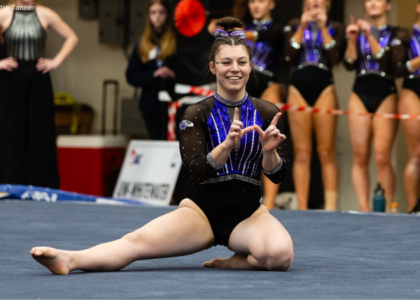As we get closer to the start of the 2024 NCAA gymnastics season, we opened up our social media channels to answer your questions about gymnastics judging. There are some really great questions here, some of which I’ve linked to other articles to give you a more in-depth answer if you need it. Read below for my thoughts on overscoring, fixing NCAA gymnastics, and my favorite competition from the judge’s seat.
How long does it take to become an NCAA judge?
For most people, a minimum of three years. For former NCAA gymnasts, only one year. In practice, most NCAA judges have 10-plus years of experience. When you sign up to judge NCAA, you are asked about your judging experience, and I imagine that is considered during the assigning process. I go into this in much more detail in my article about how to become a NCAA judge.
Are judges rated or graded throughout the season?
The short answer is no. Coaches fill out an evaluation of the judges that is submitted and received by the national assigner for NCAA gymnastics. Judges can receive their feedback at the end of the season if there are enough coach evaluations to protect the coach’s anonymity. Judges also complete a self-evaluation that asks if they believe they were prepared, professional, and fair at the competition. It’s unclear if or how these evaluations are used in assigning for the next season, and there’s no feedback during the season.
Do judges review their scoring after meets?
Immediately following the competition, the judges have to certify the scores by checking the official score sheets and making sure none of the scores have been changed or altered from the final score assigned by the head judge. The judges and head coach sign this sheet, and it is considered the official record of the scores. Coaches can also sometimes ask the judges to provide a “routine summary” where we write the deductions on a routine, for educational purposes only, for the coach. Otherwise, there’s no other review of scoring other than a “self-reflection” where judges are asked generally if they believe they judged the meet fairly and whether they were prepared.
Have you heard of or witnessed any judging biases? Seen any favoritism towards certain teams?
I asked myself this same question and did an article comparing gymnasts that switched from one team to another to see if there was any favoritism toward the more popular team. The short answer is no, I haven’t seen any favoritism toward any teams. I know judges get excited to judge big competitions or top-ranked teams because we love seeing beautiful gymnastics, but that’s as close as I’ve ever come to hearing about bias. I do think that judges are nervous to give lower scores to higher ranked teams in general. This is because the expectation is that they will score well, and when they don’t, it can be easy to second guess your deductions, especially for athletes with a lot of name recognition. For example, in Morgan Hurd’s 2023 season-opening bar routine where she had a scary fall, she got an 8.750. I had her at a 7.950 when evaluating after the fact. That’s quite a difference.
How can Haleigh Bryant score a 10.0 on bars with her dismount form?
Haleigh Bryant has scored a 10.0 once on bars, in March 2023 when she earned a historic three perfect 10s in one meet. I break down that routine in this article. I agree she has some form issues on her dismount, but leg separation on bars is very difficult to see from a side angle, and a slight knee separation on double front tucks is allowed for safety reasons. The angle of the camera is different than that of the judges, so her dismount form errors are much easier to see on TV than from the judge’s table.
Why do we see lots of 10s awarded when we rarely see true perfection?
I think it’s important to remember that as a viewer, you have the advantage of multiple angles, slow motion, and instant replay for every single routine. Judges only have one angle and about 60 to 90 seconds to come up with a score. To come up with a score, we have to write down what they did and their execution errors and then make sure they hit all of their routine and compositional requirements. While judging, we have to watch the arms, legs, torso, and posture while the gymnast is spinning and flipping rapidly through the air, while also taking notes.
Long story short, it’s a hard job, and humans are far from perfect. While most of the time we are pretty good at managing all these tasks (it is, after all, our job), sometimes we might be looking at the wrong part of the body and miss the slight leg separation, or be watching the torso and miss the step forward on the landing.
How can they improve judging consistency across all teams?
This is a great question! It’s such a great question that I actually wrote an entire article about the ways NCAA judging can be improved. I think the internal auditing of judges by other judges in a systematic, non-punitive way, as well as required judging education, would go a long way to improve consistency.
What was your favorite team to judge?
This is a tough one! A good meet to me is when the coaches and athletes are dialed in on their gymnastics, rotations and processes for judging run smoothly, and honestly, the hospitality. Getting a good night’s sleep, having a rest period after traveling, and getting in a good rhythm with your judging partner always make me feel good about a meet. I don’t have a favorite team to judge, but my favorite meet was an all-Missouri classic that was hosted by Lindenwood. The meet ran well, the gymnastics was top-notch, and it was overall a fun environment.
How should a “college stick” be deducted (in your opinion)?
Lack of control on landing is a deduction of half a tenth to two tenths. The deduction exists already, and this includes gymnasts that take one step and then try to hide the second in their salute. This year there’s a new NCAA deduction of half a tenth if the gymnast doesn’t hold their landing for at least one second. This is essentially a repackaging of the “lack of control” deduction, specifically addressing the college stick.
Do you think judging needs to be stricter?
Yes! Athletes should be getting the same scores in level 10 before NCAA as they do in NCAA, and it’s a shame that we have such a problem with consistency. I did a comparison in this article article of level 10 and NCAA routines. There are judges out there that are taking all of the deductions, but if it’s not consistent across the board, it’s still unfair. I go into this issue in more detail in this article, where I address overscoring directly.
What (if any) deductions would be beneficial to do away with?
I think some of the team-based deductions, like having your gymnasts compete out of order, excessive cheering, or some of the uniform/leotard deductions are a little bit dated and don’t really help differentiate which team was best at that competition.
Will Audrey Davis ever get a 10.0 on bars?
It’s definitely possible! I think it’s down to getting the “right” judging panel and getting better at hiding/correcting the leg form deduction in her dismount. Or changing her dismount. Everything else in her routine she’s capable of hitting perfectly. You can see a more in-depth explanation of her routine in this Judge’s Inquiry from September.
Why does judging seem to vary by conference?
This is a tough question since I don’t know what the data says regarding scoring differences by conference. One of our data editors did a deep dive into SEC scoring to see if the scoring is higher in that conference compared to others. Assuming it does vary by conference, my best guess is that it has to do with judge assignments.
For example, I live in the midwest, so most of the competitions I judged were in Illinois, Wisconsin, Michigan, Iowa, and Missouri. Competitions usually have a 50/50 split between local/in-state judges and judges that have to fly in or drive from out of state. So theoretically, half of the judging panel has likely been judging the same teams/locations for several seasons, which might create a bit of a “microculture” of judging within that conference/geographic region.
What would you do to fix NCAA scoring?
See my article: 9 ways to improve NCAA Judging.
Will the scoring system ever change to account for increased difficulty?
I’m no psychic, but my guess is it’s not likely. NCAA gymnastics is based on the USA Gymnastics Code of Points, which uses a 10.0 system, unlike the FIG Code of Points which is an open code and used for elite and international elite competitions. With the success of developmental and recreational gymnastics in the United States, I don’t see USA Gymnastics getting rid of the 10.0 system any time soon. Additionally, gymnastics has always been a balance between high difficulty and good execution. I think that prioritizing execution over excessive difficulty is better for athlete health and wellness, since these are student-athletes who have to balance both academic and athletic performance.
READ THIS NEXT: Judge’s Inquiry: Differentiating Vaults
Article by Rhiannon Franck
Rhiannon Franck is a former national-rated NAWGJ women’s gymnastics judge with over 15 years of USAG judging experience and nine seasons judging NCAA gymnastics. Outside of gymnastics, Franck works at a university as a nursing professor and loves to travel.





One comment